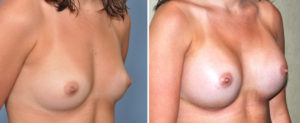
The answer to breast neurological questions comes from looking at the anatomy of the nipple-areolar complex. Although most agree that the nipple-areolar complex is innervated by the lateral and anterior branches of the intercostal nerves, controversy remains about which intercostal nerves are involved and what their anatomic course through the breast is. The fourth intercostal lateral cutaneous branch is generally regarded as the most important nerve for nipple sensitivity.
Cadaveric studies have shown innervation appears to come from both the anterior and lateral cutaneous branches of the third, fourth, or fifth intercostal nerves. Although there is some variation in the course of the nerves as they travel from the point where they perforate the deep fascia in the midaxillary line to the nipple, in the majority of patients the lateral cutaneous nerves pierce the deep fascia at the midaxillary line then travel in an inferomedial direction within the pectoral fascia or the pectoral muscle. Once it reaches the midclavicular line, the nerves turn almost 90 degrees and continue though the gland towards the posterior surface of the nipple.
In a minority of cadaveric dissections, the lateral cutaneous nerves take a more superficial course and runs in the subcutaneous tissue close to the skin and reaches the nipple from the lateral side. This is exactly where the surgical dissection may be done for a breast implant so it is easy to see how nipple-areolar sensation may potentially be disrupted if the patient’s lateral cutaneous nerve anatomy should have this anatomic pathway to the nipple.
The anterior cutaneous branches are involved in medial innervation of the nipple-areolar complex. After piercing fascia in the parasternal line, they divide into a lateral and medial branch. The medial branch crosses the lateral border of the sternum while the lateral branch divides again into several smaller branches which then take an inferolateral route through the subcutaneous tissue. These branches then take a progressively more superficial course until they reach the breast skin or the areola at the medial border (8 to 11 o’clock on the left and 1 to 4 o’clock on the right). It is these nerves which may be at risk if a periareolar incisional approach is used to place the implants.
Another factor in risk of nipple sensation loss is the size of the implant relative to the size of the native breast. Larger breasted women often have a natural decreased sensitivity of the nipple-areola complex, whether this is from traction neuropraxia of the sensory nerves or from the weight of the breast tissue causing tissue expansion of this area resulting in decreased nerve fibers per surface area is not clear. This suggests that the more breast tissue one has, the less likely a perceived loss of nipple sensation may be.
The conclusion is that the risk of some loss of nipple-areolar sensation exists in every women undergoing breast augmentation. That risk is unavoidable given how the sensory nerves course through the breast to get to the nipple. Loss of nipple sensation, in my experience, is very low but may be more likely to occur in those women whose nerve anatomy places it in harm’s way. Unfortunately there is no way to make that anatomic determination before breast augmentation surgery.
Dr. Barry Eppley
Dr. Jane Namkung
Indianapolis, Indiana


